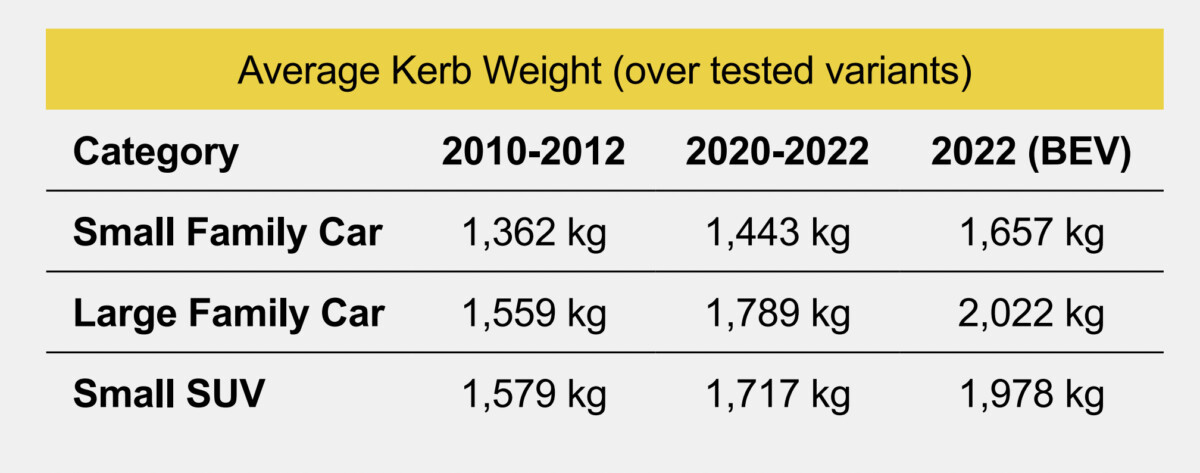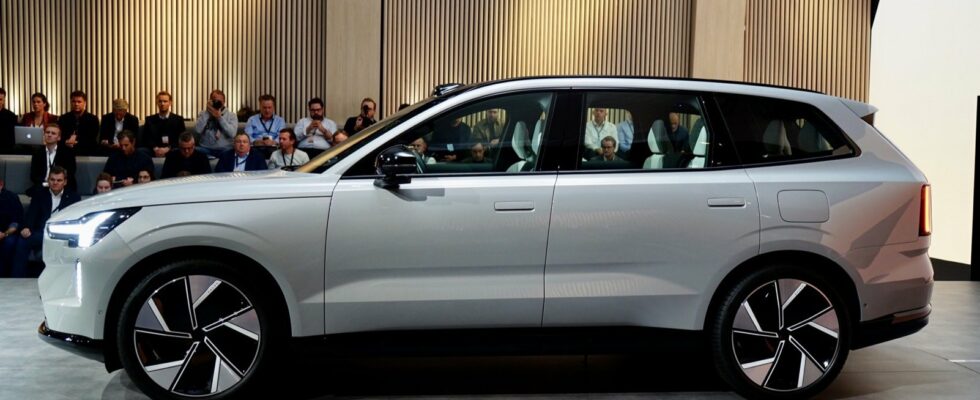It is a fact, electric cars, because of their battery in particular, are heavier than their thermal counterparts. But more generally, it is the general weight of all cars that has increased in recent years, and this will start to pose problems in terms of safety, but also from a legal point of view.
With the advent of SUVs over a decade ago, the average weight of cars has increased considerably. The democratization of electrics has only accentuated this phenomenon in recent years, and with each presentation of a new product, when we scrutinize the technical data sheet, the tab which leads us to the weight of the car in question has something to challenge us.
Latest example, the new Volvo EX90 which displays 2.8 tons on the scale. That’s 500 kilos more than a Volvo XC90 plug-in hybrid and around 700 more than a diesel model when it was still on the market.
A battery problem? Not only
Examples like this we can give you tons of (no pun intended), and that holds true on lower segment cars too. Take a Peugeot e-208 for example. It weighs 1,455 kilos, which may seem “reasonable” for an electric car. But going back ten years, we notice that a Peugeot 207, its “equivalence” at the time, weighed an average of 350 kilos less depending on the version and engine. There are of course the batteries which play a significant role in this mass gain, but there are also other determining elements.
If we want to go even further, we can take the example of a Mercedes C-Class in the 1980s, a 190 as they were called at the time, and a current C-Class. We already notice a small shift in the segments, since the old C-Class measured 4.42 meters, the length of a compact today, while the new one is 33 cm longer. In terms of weight, the first weighed between 1,080 and 1,300 kg, depending on the version. 40 years later, the Mercedes C-Class hybrid exceeds two tons.

Several problems are seriously beginning to arise with the constantly increasing weight of our cars, especially since the advent of electric vehicles and SUVs. The problem does not only affect consumption (of fuel, or electricity), the increase in the weight of cars touches on many other subjects, such as security. And, it’s quite paradoxical, we’ll see, but also more “practical” problems such as, for example, the simple fact of parking or even, and this is more surprising, for the driving licence.
Security issues
The increase in the general weight of cars is often attributed to the proliferation of mandatory safety systems, to their ever more advanced connectivity or even to driving aids. It’s a fact, and it’s all the more true since safety systems are an integral part of the Euro NCAP rating system.
If any of these aids are missing, it’s guaranteed bad grade. To make matters worse, the car in question passes for a model that is not necessarily safe and loses a significant selling point. This is for example the case for low-cost cars, which drive prices down by saving on certain technologies and, therefore, are rated less well in terms of safety. We have seen it with the Renault Zoé or the Dacia Spring, poorly rated by Euro NCAP.
In its report on the tests carried out in 2022, Euro NCAP found that the weight of the cars had increased considerably in recent years, and we can see this via this comparison table of the vehicles tested during two periods: 2010 to 2012 and 2020 to 2022. The third column is for electric vehicles tested in 2022.

You probably still have some memories of your high school physics lessons. The greater the weight of a car, the greater the force required to brake it. It therefore goes without saying that heavier cars require more powerful braking systems. That’s what we’ve seen on many new cars, whether electric or not.
Euro NCAP states in its report that the heavier a car is, the more dangerous it is, despite all the security arsenal it can carry. Difficult to give them wrong, since we dare not imagine a shock, even at 70 km / h between an electric SUV today and a city car barely ten years old.

The organization provides several solutions to work on, but we can’t help but wonder if it’s not the snake biting its own tail. Develop technologies, now mandatory, to improve the safety of cars, thus increasing their weight, making them, therefore, in another aspect, less safe, and asking manufacturers to work to further improve safety because of weight gain… in particular caused by security systems.
In fact, Euro NCAP has highlighted the need for more effective shock absorbing structures. But also more extensive work on the driving assistance systems, in order both to protect other vehicles, and vulnerable users such as cyclists and pedestrians.
Heavier, wider and longer cars, a hassle on a daily basis?
As you can see in the table presented above, in a decade, the average weight of a car has increased significantly.
The compacts took on average more than 100 kgE-segment sedans (Tesla Model 3, BMW i4, etc.) more than 200 kgwhile compact SUVs took approximately 130kg. Euro NCAP has also isolated electric cars. An electric compact weighs 1,657 kilos on average, more than two tonnes for an electric D-segment model, and 1,978 kilos for an electric compact SUV.
Heavier, our cars are also bigger, as evidenced by our example above with the Mercedes C-Class. This can also pose other problems, such as parking. The maneuvers are indeed more complicated, while the decades-old infrastructure is no longer necessarily optimal for our modern cars. You only have to see the entrance to certain underground car parks in Paris to realize this. We had also written a file that raised the question of whether electric cars were more difficult to park.


Moreover, even if the use of an electric motorization and a dedicated platform allows some advantages in terms of design (such as a shorter turning radius as proven by the Volkswagen ID. Buzz), there are also constraints. The fact that electric cars are wider is because of the batteries, but not because the battery packs are oversized for a car, it is mainly because of the security that this kind of element causes.
Manufacturers must leave some sort of “buffer” space on each side in the event of a side impact, where the battery is closest to the end of a car. In order to avoid damaging the batteries in the event of a side collision, electric cars generally use a structure with a wider side beam and a thicker sill.
Will a B permit still suffice in a few years?
This is a question that may seem exaggerated, and it is indeed at the time of this writing, but even according to Bentley, today it deserves to be asked. With a B licence, the limit imposed in terms of weight is 3.5 tonnes. It’s wide enough to drive a van, indeed, and all the cars marketed in Europe today.
But as Bentley aptly pointed out when showing off its long-wheelbase Bentayga luxury SUV (which is not a bonus electric model), license B may no longer suffice in the future. With a gross mass of 3,250 kg for his beast, indeed, we are dangerously approaching the limit. Afterwards, is this accumulation of technologies and other gadgets with which the Bentayga is equipped really necessary and will become essential for our cars of tomorrow? Certainly not.

In the same spirit, the new Volvo EX90 is at least 2.8 tons, while the new BMW i7, with all the options, largely flirts with three tons. Again, we can legitimately begin to ask questions, even if it concerns a very specific caste of cars.
Tomorrow, a 100% electric Renault 5 or a Peugeot e-208 will probably never weigh more than they weigh today, within a few kilos, especially as manufacturers become aware, despite electrification forced march, the need to contain the masses of carsand even that of the electric ones.
What can be the solutions?
One of the selling points for an electric car, it is obviously his autonomy. But as many leaders point out today, including those at Mazda, Tesla and BMW, cars with long ranges (and therefore big batteries) will soon be useless. For what ? Because charging infrastructures will multiply, but not only.
At Ford, for example, they plan to make their electric cars less complex and less expensive. Therefore, they will carry fewer things and will be less heavy in addition to being less expensive. In any case, this is what the boss of the American manufacturer recently said.
The engineers, in addition to working on new battery chemistries, are also working on the aerodynamic aspect, essential today for low consumption and good autonomy, but also on weight.

The best example, and probably the most concrete that we can give today, is the work carried out by Mercedes-Benz with its EQXX concept car. Mercedes took its Vision EQXX 1,202km across Europe, between Stuttgart and Silverstone, taking the Channel Tunnel. The 1,202 km were covered in 2:30 p.m., at an average speed of 83 km/h.
The Mercedes Vision EQXX consumed, on average, 8.3kWh/100kmin particular thanks to advanced aerodynamics (only 0.170), and also a contained weight of “only” 1.7 tons for a long electric hatchback with a battery that’s only half the size of the EQS’ 107.8kWh battery. A “conventional” electric car would have consumed almost twice as much energy on the same journey.
In the same genre, we can also mention the Lightyear 0 which had traveled more than 700 km with a consumption of approximately 8.9 kWh / 100 km and an average speed of 85 km/h. Low consumption made possible thanks to a lot of aerodynamic work (Cd of only 0.175) and above all a very contained weight of 1.6 tonnes (i.e. practically the same as a Renault Zoé), with a 60 kWh battery and a size of about five meters long.
Our colleagues from Numerama are launching Watt Else, their newsletter dedicated to the mobility of the future. Sign up here to make sure you get the first issue!
